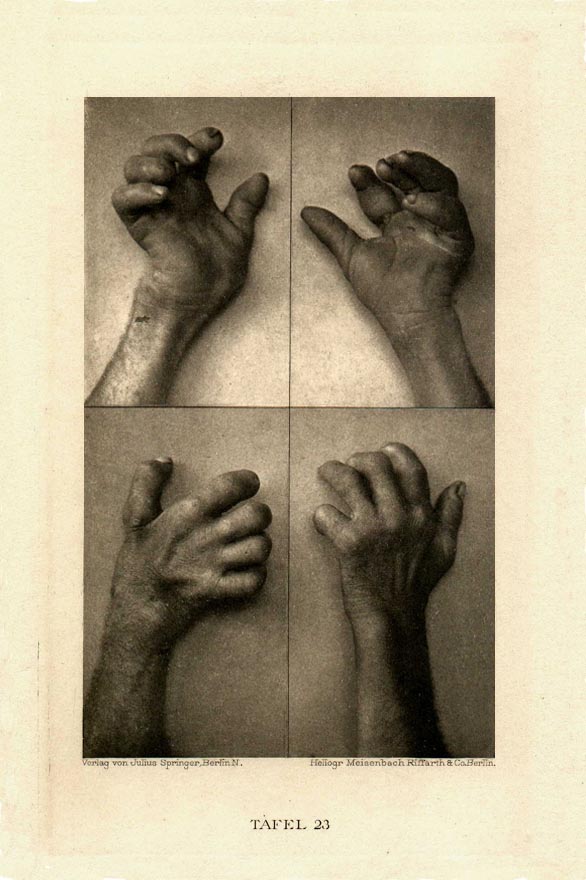
|

|

|

|
Far advanced case of the disease, with serious bilateral mutations and mutilations of the arm and hand and spastic paresis of the leg.
40 year old worker, married, father of several healthy children; hereditarily, as it appears, unencumbered; no lues.
Onset of the affliction with paresthesia in arms and legs, wobbling of the gait, spontaneous occurance of cracks, ulcers and paronychia in both hands and total wasting of the end phalanges from osteoclasis. The almost perfect absence of every sensitivity to pain was noticeable even at the first, and thereby all later requisite operations. 2 - 3 years after the occurence of the first symptoms, it more and more came about that there was an increasing muscle weakness in the hands, subsequently invoked in the forearms too, until there was a nearly total loss of function of the interossei and small finger muscles and very great reduction in the parts of the forearm musculature.
Plate 22 gives the general view of this sad disease. The torso appears crooked to the left as a result of middling scoliosis. The left eyelid fissure is somewhat constricted, the face otherwise symmetrical. Here the hands present a pair of completely deformed paws in which the enormous atrophy of the musculi interossei, the thickening and deformity of the fingers stand out. On the right, by far the most strongly altered hand, is shown the considerable swelling of the hand joints with an indication of a cicatrix from a healed caries. The complete loss of the thumb musculature is quite pronounced on the back of the hand. The thumb is subluxate in its tarsophalangeal joint, such that the nail element is deflected sharply volarwards. The finger and finger joints appear thickened, distorted in their end phalangeal joints.
The right forearm, especially when likened to the upperarm, is vastly atrophic; at the elbow one sees the residue of large skin ulcers.
The musculature of the torso seems unaltered in volume and capability, the muscle cord showing on the upperarm is somewhat slack and attenuated. Both legs offer the most distinct apparitions of spastic paresis along with considerably augmented patella reflexes and foot clonus. Bladder and rectum intact.
The sensation in the legs is generally undisturbed, while in the torso and the arms it is disturbed by palpation in a manner typical of the condition, one place even shows sensitivity to pain and temperature to be nearly entirely gone. The patient has no hint of an algesic condition or interference, particularly in the hands. Here there is no feeling, against ice as against the candent iron, against knife or pin.
Plate 23 gives individual instances for studying the mutations of both the hands.
